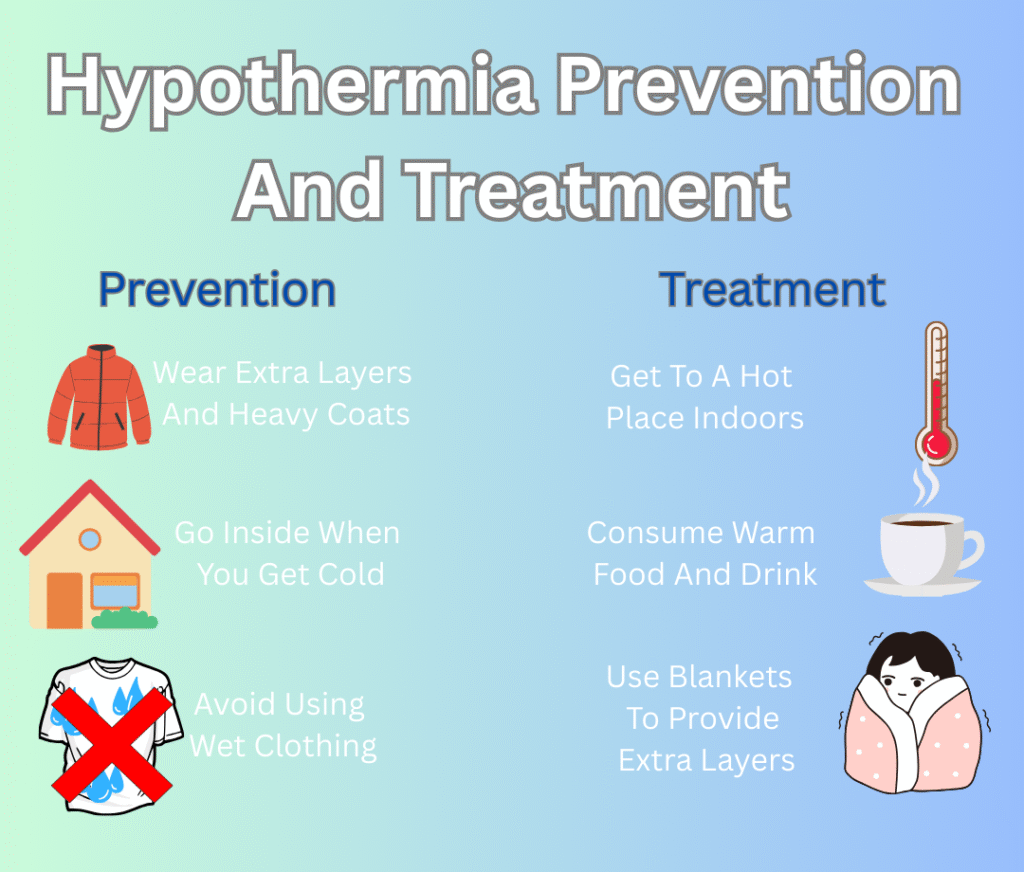What Is Hypothermia?
Hyperthermia is the condition of having a body temperature that is below 35 C (95 F), which is 2 C (3.6 F) lower than the normal body temperature of 37 C (98.6 F). An overly simple way of looking at hypothermia is that it is the opposite of a fever, however, the causes are different. A fever is often caused by the body’s immune system voluntarily increasing the heat due to an infection. Hypothermia, on the other hand, is caused by the body being unable to keep itself warm. However, just like a fever, hypothermia can be very dangerous, and in the most extreme circumstances, can cause death if not treated properly. It is estimated that approximately 8000 per year in Canada pass away due to hypothermia, with many others suffering temporary or even permanent injuries from the condition. For this reason, it is important to know how the conidtion works, as well as how to prevent it, recognize it, and in a worst-case scenario, treat it.
How Does Someone Get Hypothermia?
Someone gets hypothermia when heat leaves their body fast enough to cause their body temperature to fall below 35 C (95 F). There are several ways someone’s body temperature can drop this low. Some of the most common ways someone might get the condition include the following:
- Being outside in extremely cold weather, especially if they don’t have enough heavy layers.
- Falling into a severely cold body of water.
- Having on wet clothing if the weather is cold, especially if there is a wind chill.
- Drinking excessive alcohol in cold weather.
- Not eating or drinking enough nutritious food and water in cold weather.
- Heavy exertion in cold weather.
- Some prescription medications can cause someone to be more vulnerable to hypothermia.
It is important to note that these are just the most common examples of ways people can get hypothermia. It is important to note that if anyone is experiencing symptoms of the condition you get them to safety, or better yet, focus on preventing hypothermia in the first place.
How Can You Prevent Hypothermia?
Similar to preventing frostbite, many of the steps involved in preventing hypothermia include keeping warm. Some of the best prevention tips for hypothermia include the following:
- Wear as much extra clothing as possible. This includes wearing extra layers, as well as wearing clothing that covers the more vulnerable areas of the body, such as a hat and gloves to cover your head and hands.
- Avoid overexerting yourself. This helps your body properly save the energy it needs to keep the body warm, while also preventing sweat, which can make your clothing moist.
- Avoid being outside for long periods in cold weather.
- Avoid using wet clothing and keep the clothing you do use dry.
- Eating healthy, warm food, and drinking warm fluids if possible.
- Heating inside areas.
- Avoid or minimize consuming alcohol.
- Avoid icy areas that cover water. If the ice breaks, falling in the water can be very dangerous, or even deadly.
- Avoid activities that involve excessively touching the snow, such as making snow angels.
- Have an emergency kit ready in your car and home in case you need to stay there for a long period. Such a kit can often be referred to as a ‘bug out bag’.
Please note that this is just a list to help get you started. Anything that helps keep you healthy, dry, warm and full of energy is a good way to prevent hypothermia.
Are Some People More Vulnerable To Hypothermia?
Yes, some people are more vulnerable to hypothermia than others. The people who are more vulnerable to the condition include the following:
- The elderly. The combination of a lower metabolic rate, and other underlying conditions makes elderly people more susceptible than younger adults. This is especially true for elderly people with pre-existing conditions.
- Children naturally lose heat faster than adults, and might not have as much concern when the symptoms of hypothermia begin to show. Worse, they might not even recognize the signs at all.
- People who consume alcohol. Alcohol lowers body temperature, and having an excessive amount in a short period will have their decision-making impaired.
- Those who are mentally impaired, such as having dementia, as they will have trouble recognizing symptoms and preventing it themselves
- Those who are homeless or spend plenty of time outside in the cold
- People with pre-existing medical conditions and those on certain prescriptions might be more susceptible to hypothermia. As this is a weather blog and not a medical one, it is best that you consult a medical professional to learn more about which conditions and medications make you more vulnerable to hypothermia.
Please note that these are just the most common examples. If in doubt, it is best to assume you are vulnerable and take the needed precautions.
What Are The Stages Of Hypothermia?
There are three stages of hypothermia: Mild, moderate and Severe. Each of them is described below:
- Mild Hypothermia is when one’s body temperature ranges from 32 C (90 F) to 35 C (95 F). This stage is generally notably uncomfortable and is where you start feeling symptoms. It is advised that you get to a warm place as soon as possible to make recovery easier and ensure that further damage is not done.
- Moderate Hypothermia is when body temperature ranges from 28 C (82 F) to 32 C (90 F). This is where one can begin to feel their consciousness slip, and will generally require assistance moving.
- Severe Hypothermia is when the body temperature is less than 28 C (82 F). At this stage, someone might fall unconscious, and their vital organs might suffer permanent damage. The heart can stop entirely. If someone has severe hypothermia, they must get medical attention ASAP.
What Are The Signs And Symptoms Of Hypothermia?
The signs of hypothermia vary greatly based on whether the person who has that condition has mild, moderate, or severe hypothermia. The most common symptoms of each is listed below:
Mild Hypothermia
The symptoms of someone with hypothermia often happen because the body is trying to fight the colder temperature. Someone with mild hypothermia will likely still be able to function and respond to questions. However, they will still have many noticeable symptoms, including the following:
- Shivering
- Chattering teeth
- Feeling exhausted, sleepy, or fatigued
- Pale skin
- Weaker pulse
- Increased heart rate and/or breathing
- Loss of coordination
- Slurred speech
Please keep in mind that these are only some symptoms of mild hypothermia. There are more.
Moderate Hypothermia
If someone has moderate hypothermia, it will be very noticeable that their body is starting to shut down, as the body loses the ability to fight off coldness at this point. Someone might not be able to respond properly at this point, and medical care is needed. The most common symptoms are below:
- Stopping of slowing down of shivering
- Lower blood pressure
- Significantly lower heart rate and breathing
- Stiffness of muscles
- The skin will start to turn blue
- Dilated Pupils
- Slower reflexes
- Hallucinations
- Mental decline
- Loss of consciousness
Please note that although these are the most common symptoms, some others might appear.
Severe Hypothermia
Someone suffering from severe hypothermia will often be completely unresponsive, and is at great risk, especially if they are not already in a hospital. The most common symptoms include:
- Ceasing of shivering
- No reflexes or ability to move voluntarily
- Fluid in lungs
- Stopping heart rate, breathing or pulse
- Entering a coma
Severe hypothermia has a high death rate, and someone in that state must be brought to a hospital as quickly as possible.

What Are The Dangers Of Hypothermia?
Hypothermia can impact one’s vital organs and even directly lead to death. It can do permanent damage to your liver, lungs or heart, and can even kill you by causing the heart to stop entirely. Even if someone survives, they can have permanent damage to these organs, and many people who have hypothermia even get frostbite.
How To Treat Hypothermia
When treating hypothermia, it is best to call 911 for medical attention, and then do everything you can to prevent the person from losing more heat. Some of the things you can do before medical help arrives include the following:
- Get the person to a dry, warm location indoors.
- Replace wet clothing with dry clothing. Dry the person and ensure that the added clothing is thick. Using a blanket is advised. Hats, jackets, and other additional forms of extra clothing are also helpful.
- Place external heat sources, such as heat packs, on the person’s most sensitive areas. These include the armpits, hands, feet and face.
- Offer warm fluids such as hot chocolate and warm soup. Avoid Caffeine and Alcohol. Warm, healthy food can also be helpful.
Keep the person as comfortable as possible until medical help arrives and then allow the medical professionals to take care of the person in question.
